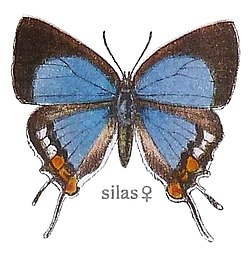| Southern sapphire | |
|---|---|
 | |
 | |
| Female and male | |
| Scientific classification | |
| Kingdom: | Animalia |
| Phylum: | Arthropoda |
| Class: | Insecta |
| Order: | Lepidoptera |
| Family: | Lycaenidae |
| Genus: | Iolaus |
| Species: | I. silas |
| Binomial name | |
| Iolaus silas | |
| Synonyms | |
| |
Iolaus silas, the southern sapphire, is a butterfly of the family Lycaenidae which is endemic to South Africa.
